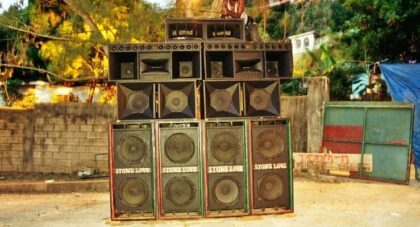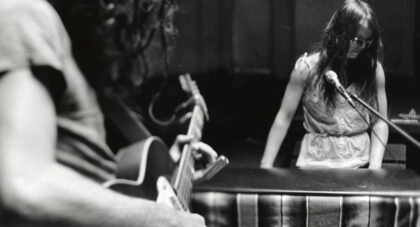Welcome to the second installment of the Aquarium Drunkard guide to ECM Records. Marked by an attention to sonic space and a distinct visual aesthetic, since 1969 ECM has released a wide amalgamation of jazz, fusion, modern classical, avant-garde, world music and beyond. By no means a comprehensive compendium, like our first installment, the following selection of output spans various decades, styles and genres, exemplifying the breadth and depth of the label's ongoing pursuit.
Terje Rypdal / S/T: Miles Davis was only a few years into his electric period when Terje Rypdal’s first record for ECM came out in 1971. But somehow, the Norwegian guitarist had fully absorbed Miles’ Jack Johnson-era style. Check out the 12-minute opener “Keep It Like That—Tight” (you can even imagine Miles rasping a phrase like that). It’s a brilliantly tense piece of future funk, with a sinister bassline, skittering drums, spine-tingling electric keys and chilly wah guitar action. ECM stalwart Jan Garbarek nearly steals the show with his burning sax solo at the mid-point, but you’ll want to hang out ‘til the end for Rypdal’s incredible fuzz freak-out. Monstrous. The rest of the LP isn’t quite so beholden to Miles, though there are many high points – “Rainbow” is a weirdly beautiful drift, and the lengthy “Electric Fantasy” is an early ambient/orchestral jam, with disembodied vocals and woodwinds floating over an unsettled groove. This was just the beginning of a relationship with ECM that continued well into the 21st century. Rypdal got off to a great start.
John Abercrombie, Dave Holland, Jack DeJohnette / Gateway: Recorded shortly after the sessions for Colin Walcott's Cloud Dance lp, 1975's Gateway finds John Abercrombie, Dave Holland and Jack DeJohnette regrouping and in rare form. Over the course of the album's six tracks the group run the voodoo down and back again. Beginning with the dark groove of "Backwoods Song", things get ominous and out there without ever sacrificing melodic thrust and momentum. More raw and rough-hewn than the majority of the ECM stable at the time, Gateway's early fusion is bluesy, spooky and at times just nasty.
Bengt Berger w/ Don Cherry / Bitter Funeral Beer: A strong contender for most interesting album title in the ECM catalog, Swedish percussionist Bengt Berger’s Bitter Funeral Beer is a masterful study of West African music and a glowing testament to the label’s dedication to music without boundaries. The album sees Berger’s band interpret traditional folk themes from Ghanaian funeral music and blend them with the spiritual jazz and avant improvisation of Don Cherry. The group plays as a true ensemble and no single voice outshines the rest, but rather each successive part heightens the group as a whole. Similarly, there’s no single track highlight on this one... the whole thing rips!
Garth Knox / Saltarello: Renowned for developing inventive yet approachable extended string techniques on Viola Spaces, Garth Knox curates a repertoire on Saltarello that frames his own compositions with music by the 12th century German abbess and mystic Hildegard von Bingen to contemporary Finnish composer Kaija Saariaho. Knox frequently utilizes a viola d’gamba, a baroque-era bowed instrument with sympathetic strings that adds an ethereal resonance to the melodius, sometimes folksy tunes conjured on Saltarello. The name itself refers to a 14th century Italian court dance, and the record’s foray through the ages shows what fun can be had at the intersection of “early music” and “new music.” Whimsical fiddling is girded by deep compositional roots, whether on Knox’s spritely interpretation of “Black Brittany” or on “Fuga Libre,” an original with a punny name that outlines Knox’s inspirations quite succinctly.
Meredith Monk / Book Of Days: Monk’s fourth album on ECM’s classical-focused New Series continues her exploration of “voice as an instrument.” As with most of Monk’s music, Book of Days is accompanied by a visual component, though the record certainly stands as its own work. The imagery is lush enough as it is - Monk’s singers use whispers, chants, breathing, and ululations to paint the passing of the sun, moving travelers, a young girl and a madwoman’s visions, the plague. Monk achieves all of this without words, striking at something deeper through what she believes to be the ancient power of the voice “that within it were all these feelings that we don’t have words for.”
Wolfgang Dauner / Output: A known outlier in the vast ECM catalog, Output ECM 1006 contains hints of later characteristic ECM sounds (eastern strings & percussion, cinematic piano, electronics) but presents these elements with much more raw and explosive energy than typical of the label’s later more crystalline sound. Combining jazz, kraut, and world music, Dauner (ring-modulated clavinet, piano), Weber (bass, cello, guitar), and Braceful (percussion, voice) manage to create a wholly unique beast that is somehow all and none of its influences at once, making for a potentially difficult first listen. Take this one out for a couple spins before passing judgement - repeated listens highly recommended!
Only the good shit. Aquarium Drunkard is powered by its patrons. Keep the servers humming and help us continue doing it by pledging your support.
To continue reading, become a member or log in.


